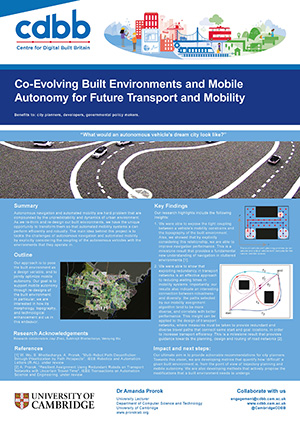Co-Evolving Built Environments and Mobile Autonomy for Future Transport and Mobility Amanda Prorok, University of Cambridge
Dr Amanda Prorok, University of Cambridge
'Evolving Built Environments and Mobile Autonomy for Future Transport and Mobilty'
What would an autonomous vehicle’s dream city look like?
Autonomous navigation is a hard problem that is compounded by the unpredictability and dynamics of urban environments. As we re-think and re-design our built environments, we have the unique opportunity to transform them so that autonomous vehicles can navigate efficiently and robustly. The main idea behind this project is to tackle the challenges of autonomous navigation by explicitly considering the coupling of the autonomous vehicles with the environments that they operate in.
Outline:
Our approach is to pose the built environment as a design variable, and to jointly optimize mobile autonomy. Our goal is to support mobile autonomy through enhanced infrastructure with embedded networks of heterogeneous sensors that cooperate with the autonomous vehicles.
Specifically, we will develop methods that optimize the placement and configuration of sensor nodes for perceptive infrastructure in aid of mobile autonomy. For example, we envision perceptive sidewalks that detect anomalous pedestrian activity and alert oncoming vehicles; we envision perceptive road networks that infer the state of traffic, to optimally coordinate and route vehicle trajectories; we envision perceptive landmarks that can localize lost vehicles. This begs the question: What is the optimal placement of sensor nodes for an optimally enhanced infrastructure?
Unfortunately, the sensor placement problem is hard to solve: the number of possible sensor configurations scales exponentially, and classical combinatorial optimization methods are intractable for large-scale problems. Tools from data science, machine learning and predictive analytics are now being routinely used to solve such complex decision-making problems, yet, they come with the burden of requiring vast amounts of data. This project aims to provide new tools in support of a novel framework that facilitates the development of enhanced infrastructure for mobile autonomy in built environments.
Our research program strives to achieve the following three goals:
- We will study how enhanced, perceptive infrastructure can increase the robustness of autonomous systems in complex, dynamic scenarios by providing contextual information that facilitates resilient path planning over longer time-horizons, beyond a vehicle’s local line-of-sight and field-of-view.
- We will plan on providing solutions to massively large-scale problems that include hundreds or thousands of heterogeneous integrated sensor nodes.
- We plan to accommodate specific topographical variables and constraints that are encountered in the built environment. These variables will include geometric parameterizations of road architecture, lane topographies, and road-side landmarks.
Contact: Amanda Prorok

